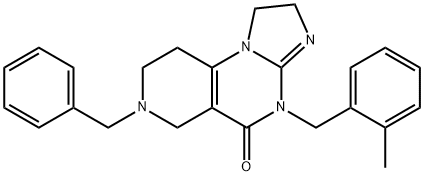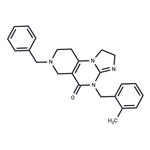TIC10 induces the expression of TNF-related apoptosis-inducing ligand (TRAIL) at 1-5 μM in a p53-independent manner. It is orally active, stable, and crosses the blood-brain barrier. The induction of TRAIL results from dual inhibition of Akt and ERK1/2 combined with nuclear translocation of the transcription factor FOXO3a. TIC10 suppresses the growth of orthotopic human glioblastoma multiforme tumors in mice.
7-Benzyl-4-(2-methylbenzyl)-1,2,6,7,8,9-hexahydroimidazo[1,2-a]pyrido[3,4-e]pyrimidin-5(4H)-one is used in biological studies for structure confirmation and pharmacophore reassignment for induction of immunosurveillance cytokine TRAIL in macrophages. The structure of this compound was misassigned for many years as H291055. The resolution of this issue was recently highlighted in Chemical and Engeneering News 92(23) 32 (2014).
TIC10 (also named ONC21), a first-in-class small molecule inducer of TRAIL, has been developed. Preclinical studies have shown that it potently induces TRAIL expression. TIC10 treatment in cancer cells blocks Akt and Erk signalling to activate Foxo3a, which transcriptionally up-regulates the TRAIL gene. TIC10 has displayed ideal properties as a potential anti-cancer drug, including a broad spectrum of activity, wide safety margin, robust stability, aqueous solubility, favourable pharmacokinetics, and oral activity[5].
TIC10/ONC201, a first-in-class small-molecule inducer of tumor necrosis (TNF)-related apoptosis-inducing ligand (TRAIL). The in vitro results showed that TIC10 induced potent cytotoxic and cytostatic activities in several human pancreatic cancer cell lines (Panc-1, Mia-PaCa2, AsPC-1 or L3.6). TIC10 activated both extrinsic (TRAIL-caspase-8-dependent) and endogenous/mitochondrial (caspase-9-dependent) apoptosis pathways in the pancreatic cancer cells. Molecularly, TIC10 inhibited Akt-Erk activation yet induced TRAIL expression in pancreatic cancer cells. Significantly, TIC10, at a relatively low concentration, sensitized gemcitabine-induced growth inhibition and apoptosis against pancreatic cancer cells. Further, TIC10 and gemcitabine synergistically inhibited Panc-1 xenograft growth in SCID mice. The combination treatment also significantly improved mice survival. In addition, Akt-Erk in-activation and TRAIL/cleaved-caspase-8 induction were observed in TIC10-treated Panc-1 xenografts[5].
1) Allen?et al.?(2013)?Dual Inactivation of Akt and ERK by TIC10 Signals Foxo3a Nuclear Translocation, TRAIL Gene Induction, and Potent Antitumor Effects, Sci. Transl. Med.?5?171ra17
2) Allen?et al.?(2015)?Identification of TRAIL-inducing compounds highlights small molecule ONC201/TIC10 as a unique anti-cancer agent that activates the TRAIL pathway,?Mol. Cancer.?14?99
3) Allen?et al.?(2016)?Discovery and Clinical Introduction of First-In-Class Imipridone ONC201, Oncotarget?7?74380
4) Ishizawa?et al.?(2019)?Mitochondrial ClpP-Mediated Proteolysis Induces Selective Cancer Cell Lethality, Cancer Cell?35?721
[6] Qiangbo Zhang . “The preclinical evaluation of TIC10/ONC201 as an anti-pancreatic cancer agent.” Biochemical and biophysical research communications 476 4 (2016): Pages 260-266.



![4-[5-methyl-4-[(4-methylphenyl)sulfonylmethyl]-1,3-oxazol-2-yl]-N-(pyridin-3-ylmethyl)benzamide pictures](https://img.chemicalbook.com/ProductImageEN/2020-1/Small/741ceb00-1510-4d9f-bf96-8720f0596e09.png)